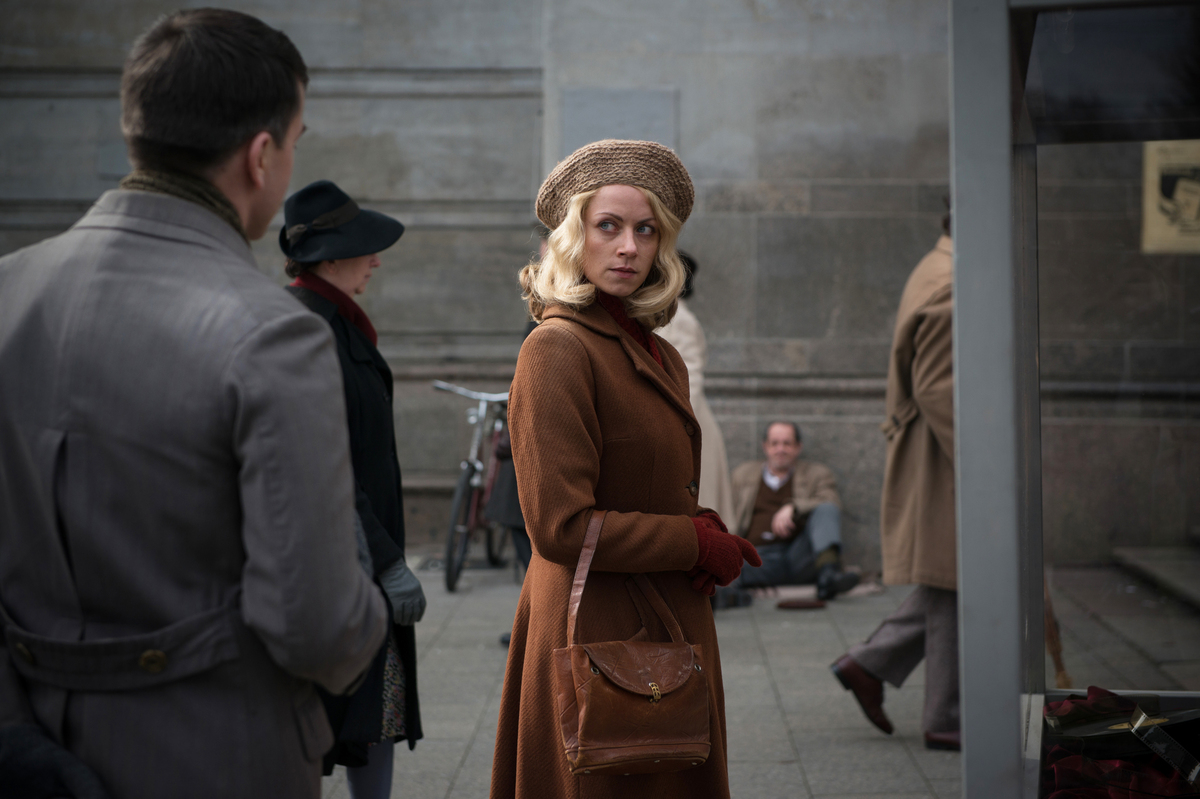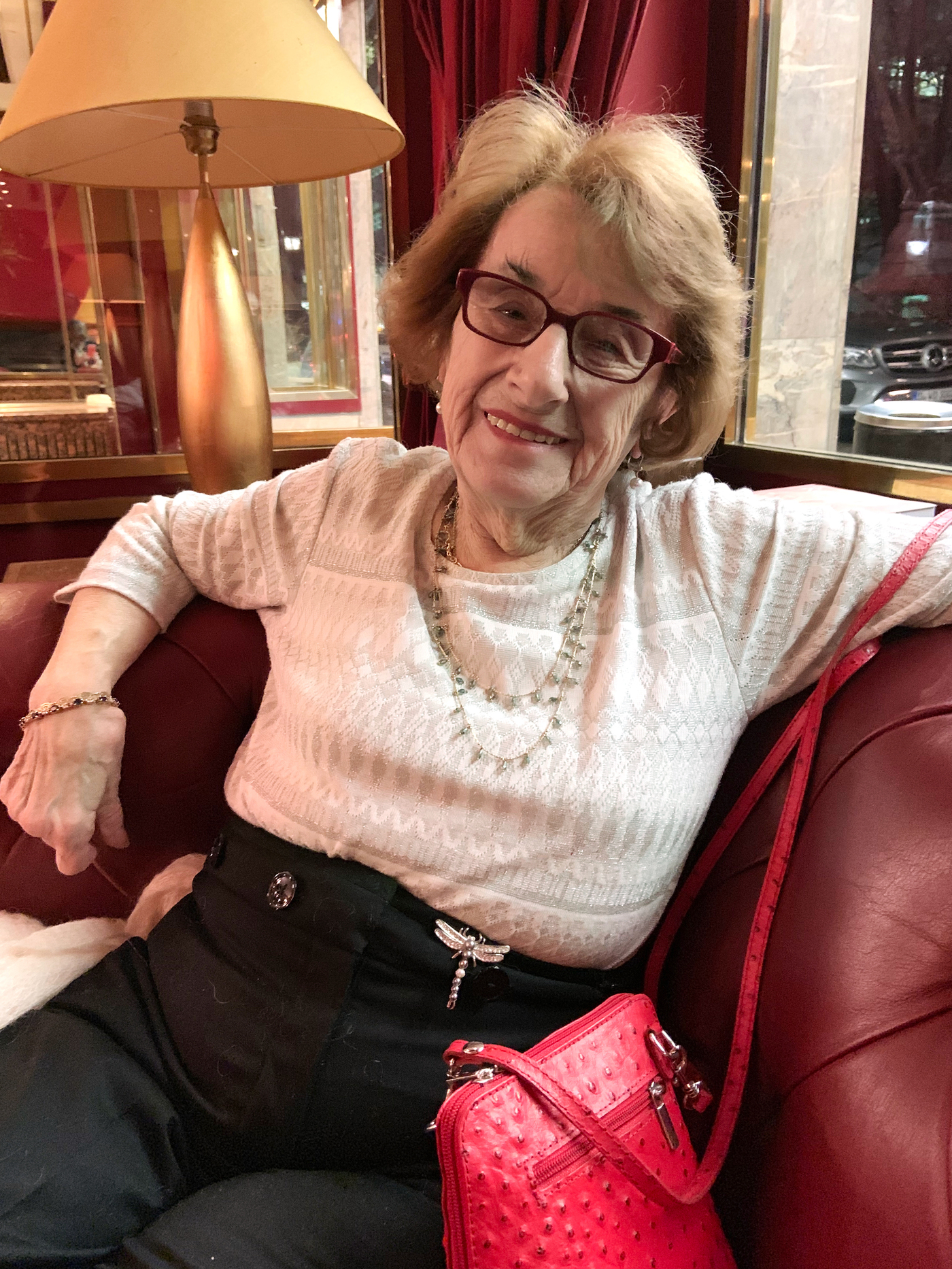what happen to the jews that got caught

Alice Dwyer plays the young Hanni Lévy in The Invisibles, which focuses on the lives of four High german Jews who stayed in Germany during World War Ii and survived. Greenwich Entertainment hide caption
toggle caption
Greenwich Entertainment

Alice Dwyer plays the young Hanni Lévy in The Invisibles, which focuses on the lives of iv German language Jews who stayed in Frg during World War 2 and survived.
Greenwich Entertainment
Hanni Weissenberg, now Hanni Lévy, survived as a Jew in Nazi Germany.
Today, the petite and lively 94-twelvemonth-old lives in Paris. Earlier this calendar month, she returned to Berlin, her home during the state of war years, to attend the screening of a film about her and other Jews who survived while hiding under the noses of the Nazis.
The Invisibles, a German language documentary-drama based on the accounts of four survivors, opened Friday in the U.Southward.
In the flick, Lévy is depicted offset at age 17, sitting in her Berlin flat in 1943, with the Gestapo pounding on the door.
"That's when I knew it was now or never," Lévy tells NPR. "I knew I had to disappear. When they knocked like that, usually yous had to open up. But I didn't."
She managed to slip out of the apartment that day and escape.
Her parents had died of illness. Her grandmother and another Jewish family unit she had lived with had been deported. She was living lonely and working as a forced laborer at a manufacturing plant, sewing parachutes. In Feb 1943, the Gestapo carried out the Fabrik-Aktion or "factory action," the last major arrest of Jews to be deported to Auschwitz.
Taking but her coat and handbag, Lévy hid in her big apartment edifice until nightfall. Then she made her way to the home of non-Jewish friends of her parents, the only people she felt she could trust. They took her in. Information technology would be the outset of many such places of refuge.
Staying with these family friends, Lévy removed the yellowish star that Nazis forced Jews to wear, dyed her hair blond and began a new life as Hannelore Winkler.
"You just had to ignore the fear in your gut and push information technology away, go someone else," Lévy says. "I had to effort to lose myself in the masses and forget that I was scared and that I was someone who once submitted to the Nazi race laws. I had to act like a regular Berliner. And this is what saved me in the end."

"I knew it was now or never," says Hanni Lévy, 94, recalling when the Gestapo knocked on her door in 1943. "I knew I had to disappear." Eleanor Beardsley/NPR hibernate caption
toggle caption
Eleanor Beardsley/NPR

"I knew it was now or never," says Hanni Lévy, 94, recalling when the Gestapo knocked on her door in 1943. "I knew I had to disappear."
Eleanor Beardsley/NPR
Barbara Schieb, a historian with Berlin's German Resistance Memorial Centre, says Jews often went completely underground in Nazi-occupied countries, sometimes helped by resistance movements. But for Jews in Germany — where potentially anybody was a Nazi and in that location was no organized resistance — Schieb says people had to hide in plain sight.
"They just said, 'I'thousand somebody else,' " says Schieb. "They invented a new Aryan-sounding identity. And for this, they needed helpers. They needed a dwelling, something to consume, coin, of form — and they needed false documents. But they were visible. Y'all see information technology in the picture show, how they are working, meeting. And yet they are invisible. Information technology'due south the false identity that is visible."
German director and producer Claus Räfle, a xxx-yr veteran of the film manufacture, says he made The Invisibles because he finds the stories of people who have to hide themselves in their own hometown amazing.
"They have to climb into different identities, and these stories are so full of tension and emotions because every twenty-four hours is total of risks," he tells NPR. "Every solar day, you tin can be arrested. Every twenty-four hours, someone tin notice something strange almost you. And I thought this is something that never happened before."
Räfle's moving-picture show, a drama re-created around the interviews with survivors, is interspersed with footage of Berlin during the war. It was released in Germany in 2017 and aired on High german prime-time television final week.
"These are some of the last victims of Nazism who could tell their story in a very interesting and touching way," he says. "It proved it happened and that some people were helping, and that fabricated a deviation."
In improver to Lévy's story, the moving-picture show focuses on the survival of three other young Jewish Berlin residents who fabricated it through the war years. Today, Lévy is the only i of those four still living.
One of the other survivors, Cioma Schönhaus, was an art student who became an adept forger of documents. Another, Ruth Arndt, was a young adult female who worked in a German language officeholder's house. He knew she was Jewish but kept the hole-and-corner. Eugen Herman-Friede escaped suspicion by wearing the Hitler Youth uniform of the son of the family who hid him.
In the film, for which interviews were conducted 10 years ago, the iv survivors talk of the constant fear, the hunger and common cold they experienced. They call back a culture of denunciation then pervasive that sometimes Jews denounced other Jews in the promise of avoiding a horrible fate.
But they likewise talk with admiration almost the people who helped them survive. "These people sheltering me had to live with just ane nutrient ration card," Lévy tells NPR. As Allied bombings of Berlin increased most the end of the war, "they often went into public bunkers with me so I wouldn't be seen in their basement. They kind of sacrificed themselves to live my life."
Stories of the thousands of Jews who went into hiding in the eye of Nazi Germany merely came to light in the late 1980s, says Schieb. It took the generations built-in after the war to unearth and document them.
"It'due south tragic, merely that's the manner it is," says Schieb. "The starting time generation of this [postwar] country was not capable of doing this research. It was the next generation who pushed it. They asked, how could all this happen?"
Schieb says most 1,900 Jews survived the war while hiding in and around Berlin. Some of the stories of those who helped them are documented at the German Resistance Memorial Center in an exhibition chosen "Silent Heroes."
Schieb says that in 1933, near half a million Jews lived in Germany, which so had a population of 80 meg. A third of the country's Jews lived in Berlin. She says near 300,000 Jews escaped before the Holocaust and 165,000 were deported. The survivors included those in mixed marriages, those who returned from the concentration camps and those who went into hiding.
Michael Müller was among those in the audience at the Berlin screening of The Invisibles. Of Lévy, he says, "She helps us business relationship for our difficult past and larn for the future."
Marianne Enzensberger, 72, also in the audience, marveled at Lévy's generosity. "I adore this lady, that she tin can forgive everybody," she says. "I would never be able to do that. I can't forgive my own people for what they did."
With her was a friend, Marianne Rosenberg, whose father was Jewish and survived Auschwitz. Both women say they are worried today about the rising of the far correct in Federal republic of germany and Eastern Europe.
"I'm very angry about what'due south happening," says Enzensberger. "German language people say, 'Oh, this happened so long ago,' but information technology was just a flash in history, a few short years ago. And some of the youngsters today, they don't know virtually anything."
Sophie Achenbach, 26, was stunned past The Invisibles. She says she knew most the horrors of Auschwitz but never imagined the daily injustices in the metropolis where she lives that led upwardly to the Holocaust.
"If you picket the flick and think almost the daily lives they had — that Jews couldn't get to the physician, that they couldn't utilise the public transportation, all these things," says Achenbach, "I never thought about that. And living in Berlin, this all felt very close to me. Where the movie takes identify is where you walk every solar day."
Like about German Jewish survivors, Lévy left Germany after the war. She has lived in Paris since 1946 and says Paris is her abode, the place where she has raised her happy family.
But she calls Berlin her hush-hush garden.
"I can't forget the time I lived in Berlin," she says. "I lost my parents, and my grandmother was deported. I started another life here and lived on the margins. It's not possible to strike that from my life."
Lévy says she has no bitterness — only gratitude for the boggling people who helped her stay alive.
Source: https://www.npr.org/2019/01/29/689272533/the-invisibles-reveals-how-some-jews-survived-nazi-germany-by-hiding-in-plain-si
0 Response to "what happen to the jews that got caught"
Post a Comment